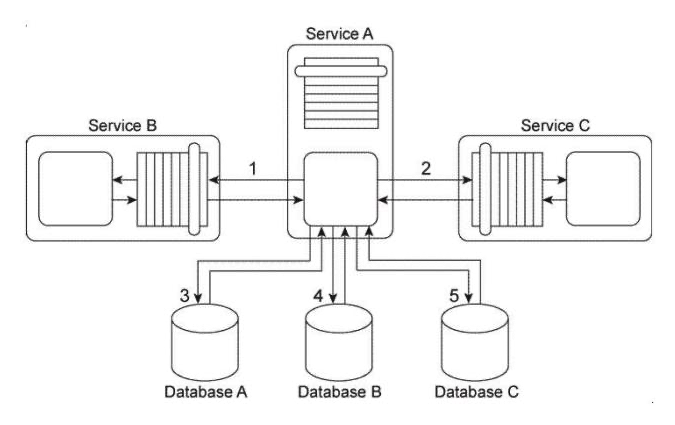Service A is an entity service that provides a set of generic and reusable service capabilities. In order to carry out the functionality of any one of its service capabilities, Service A is required to compose Service B (1) and Service C (2) and Service A is required to access Database A (3) , Database B (4) , and Database C (5) . These three databases are shared by other applications within the IT enterprise. All of service capabilities provided by Service A are synchronous, which means that for each request a service consumer makes. Service A is required to issue a response message after all of the processing has completed. Depending on the nature of the service consumer request, Service A may be required to hold data it receives in memory until its underlying processing completes. This includes data it may receive from either Service A or Service B or from any of the three shared databases. Service A is one of many entity services that reside in a highly normalized service inventory. Because Service A provides agnostic logic, it is heavily reused and is currently part of many service compositions.  You are told that Service A has recently become unstable and unreliable and several of the service consumers that access it have had to raise runtime exceptions due to these problems. What steps can be taken to solve these problems without compromising the normalization of the service inventory?
You are told that Service A has recently become unstable and unreliable and several of the service consumers that access it have had to raise runtime exceptions due to these problems. What steps can be taken to solve these problems without compromising the normalization of the service inventory?
Definitions:
Cherry Orchard
A cultivated area where cherry trees are grown for fruit production.
Marginal Cost
The cost of producing an additional unit of a good or service.
Average Total Cost
The total cost of production (fixed plus variable costs) divided by the total quantity produced, representing the per-unit cost of production.
Average Total Cost
The total cost of production divided by the number of goods produced, representing the per-unit production cost.
Q11: Which of the following is Correct?<br>A) the
Q44: You want to prevent unauthorized switches from
Q48: Users at a remote site report that
Q55: Quality of a walkthrough depends on preparation
Q63: A company needs to replicate a database
Q90: To qualify as a service composition, at
Q104: With fixed deferred annuities;<br>A) the credited rate
Q200: _ is an agreement between two counterparties
Q204: Direct serving loans method requires a system
Q234: What provide for monetary compensation to third